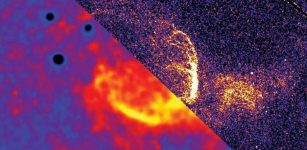Detection Of Non-Thermal Emission From Classical Nova With A Dwarf Companion
Eddie Gonzales Jr. – MessageToEagle.com – While studying classical novae using the National Radio Astronomy Observatory’s Very Long Baseline Array (VLBA), a graduate researcher uncovered evidence showing that the objects may have been erroneously typecast as simple.
This artist’s conception depicts V1674 Herculis, a classical nova hosted in a binary star system that is made up of a white dwarf and dwarf companion star. Scientists studying this nova have detected non-thermal emission, a departure from the historical belief that these systems produce only thermal emissions. Credit: B. Saxton (NRAO/AUI/NSF)
The new observations, which detected non-thermal emission from a classical nova with a dwarf companion, were presented at a press conference during the 242nd proceedings of the American Astronomical Society in Albuquerque, New Mexico.
V1674 Herculis is a classical nova hosted by a white dwarf and dwarf companion and is currently the fastest classical nova on record. While studying V1674Her with the VLBA, Montana Williams, a graduate student at New Mexico Tech who is leading the investigation into the VLBA properties of this nova, confirmed the unexpected: non-thermal emission coming from it. This data is important because it tells Williams and collaborators a lot about what’s happening in the system.
What the team has found is anything but the simple heat-induced explosions scientists previously expected from classical novae.
“Classical novae have historically been considered simple explosions, emitting mostly thermal energy,” said Williams. “However, based on recent observations with the Fermi Large Area Telescope, this simple model is not entirely correct. Instead, it seems they’re a bit more complicated.
Scientists studying the classical nova V1674Her have confirmed the presence of non-thermal emissions. The nova, which was discovered in 2021, is the fastest classical nova on record. This side-by-side shows the difference in brightness over just four days. Credit: M. Williams/New Mexico Tech, B. Saxton (NRAO/AUI/NSF)
Using the VLBA, we were able to get a very detailed picture of one of the main complications, the non-thermal emission.”
Very long baseline interferometry (VLBI) detections of classical novae with dwarf companions like V1674Her are rare. They’re so rare, in fact, that this same type of detection, with resolved radio synchrotron components, has been reported just one other time to date. That’s partly because of the assumed nature of classical novae.
“VLBI detections of novae are only recently becoming possible because of improvements to VLBI techniques, most notably the sensitivity of the instruments and the increasing bandwidth or the amount of frequencies we can record at a given time,” said Williams. “Additionally, because of the previous theory of classical novae they weren’t thought to be ideal targets for VLBI studies. We now know this isn’t true because of multi-wavelength observations which indicate a more complex scenario.”
That rarity makes the team’s new observations an important step in understanding the hidden lives of classical novae and what ultimately leads to their explosive behavior.
V1674Her is a classical nova located in the constellation Hercules. Credit: IAU/Sky & Telescope
“By studying images from the VLBA and comparing them to other observations from the Very Large Array (VLA), Fermi-LAT, Nu-Star, and NASA-Swift, we can determine what might be the cause of the emission and also make adjustments to the previous simple model,” said Williams. “Right now, we’re trying to determine if the non-thermal energy is coming from clumps of gas running into other clumped gas which produces shocks, or something else.”
Because Fermi-LAT and Nu-Star observations had already indicated that there might be non-thermal emission coming from V1674Her, that made the classical nova an ideal candidate for study because the team are on a mission to either confirm or deny those types of findings. It was also more interesting, or cute, as Williams puts it, because of its hyper-fast evolution, and because, unlike supernovae, the host system isn’t destroyed during that evolution, but rather, remains almost completely intact and unchanged after the explosion.
“Many astronomical sources don’t change much over the course of a year or even 100 years. But this nova got 10,000 times brighter in a single day, then faded back to its normal state in just about 100 days,” Williams said. “Because the host systems of classical novae remain intact they can be recurrent, which means we might see this one erupt, or cutely explode, again and again, giving us more opportunities to understand why and how it does.”
Source – National Radio Astronomy Observatory
Written by Eddie Gonzales Jr. – MessageToEagle.com Staff













![galaxy candidate is some 13.5 billion light-years away and is described Thursday in the Astrophysical Journal. In an accompanying paper published in the Monthly Notices of the Royal Astronomical Society Letters, scientists have begun to speculate exactly what the galaxy is. The team proposes two ideas: HD1 may be forming stars at an astounding rate and is possibly even home to Population III stars, the universe's very first stars—which, until now, have never been observed. Alternatively, HD1 may contain a supermassive black hole about 100 million times the mass of our Sun. "Answering questions about the nature of a source so far away can be challenging," says Fabio Pacucci, lead author of the MNRAS study, co-author in the discovery paper on ApJ, and an astronomer at the Center for Astrophysics. "It's like guessing the nationality of a ship from the flag it flies, while being faraway ashore, with the vessel in the middle of a gale and dense fog. One can maybe see some colors and shapes of the flag, but not in their entirety. It's ultimately a long game of analysis and exclusion of implausible scenarios." HD1 is extremely bright in ultraviolet light. To explain this, "some energetic processes are occurring there or, better yet, did occur some billions of years ago," Pacucci says. At first, the researchers assumed HD1 was a standard starburst galaxy, a galaxy that is creating stars at a high rate. But after calculating how many stars HD1 was producing, they obtained "an incredible rate—HD1 would be forming more than 100 stars every single year. This is at least 10 times higher than what we expect for these galaxies." That's when the team began suspecting that HD1 might not be forming normal, everyday stars. "The very first population of stars that formed in the universe were more massive, more luminous and hotter than modern stars," Pacucci says. "If we assume the stars produced in HD1 are these first, or Population III, stars, then its properties could be explained more easily. In fact, Population III stars are capable of producing more UV light than normal stars, which could clarify the extreme ultraviolet luminosity of HD1." Timeline displays the earliest galaxy candidates and the history of the universe. Credit: Harikane et al., NASA, EST and P. Oesch/Yale. A supermassive black hole, however, could also explain the extreme luminosity of HD1. As it gobbles down enormous amounts of gas, high energy photons may be emitted by the region around the black hole. If that's the case, it would be by far the earliest supermassive black hole known to humankind, observed much closer in time to the Big Bang compared to the current record-holder. "HD1 would represent a giant baby in the delivery room of the early universe," says Avi Loeb an astronomer at the Center for Astrophysics and co-author on the MNRAS study. "It breaks the highest quasar redshift on record by almost a factor of two, a remarkable feat." HD1 was discovered after more than 1,200 hours of observing time with the Subaru Telescope, VISTA Telescope, UK Infrared Telescope and Spitzer Space Telescope. "It was very hard work to find HD1 out of more than 700,000 objects," says Yuichi Harikane, an astronomer at the University of Tokyo who discovered the galaxy. "HD1's red color matched the expected characteristics of a galaxy 13.5 billion light-years away surprisingly well, giving me a little bit of goosebumps when I found it." The team then conducted follow-up observations using the Atacama Large Millimeter/submillimeter Array (ALMA) to confirm the distance, which is 100 million light years further than GN-z11, the current record-holder for the furthest galaxy. Using the James Webb Space Telescope, the research team will soon once again observe HD1 to verify its distance from Earth. If current calculations prove correct, HD1 will be the most distant—and oldest—galaxy ever recorded. The same observations will allow the team to dig deeper into HD1's identity and confirm if one of their theories is correct. "Forming a few hundred million years after the Big Bang, a black hole in HD1 must have grown out of a massive seed at an unprecedented rate," Loeb says. "Once again, nature appears to be more imaginative than we are." Explore further Astronomers confront massive black hole at the heart of the Milky Way, Sagittarius A* More information: A Search for H-Dropout Lyman Break Galaxies at z~12-16, arXiv:2112.09141 [astro-ph.GA] arxiv.org/abs/2112.09141 , Accepted for publication in MNRAS Letters. Are the newly-discovered z∼13 drop-out sources starburst galaxies or quasars?, arXiv:2201.00823 [astro-ph.GA] arxiv.org/abs/2201.00823 , Accepted for publication in ApJ. Journal information: Astrophysical Journal , Monthly Notices of the Royal Astronomical Society Letters , Monthly Notices of the Royal Astronomical Society Provided by Harvard-Smithsonian Center for Astrophysics Facebook Twitter Email Feedback to editors Featured Last Comments Popular Megathrust earthquake and tsunami 3,800 years ago kept hunter-gathers in Chile inland for 1,000 years 4 HOURS AGO 1 Identifying the basic structure of the language of fungi 6 HOURS AGO 0 Two new Saturn-mass exoplanets discovered 6 HOURS AGO 1 Astronomers inspect nova T Aurigae with Hubble APR 06, 2022 1 Astrophysicists theorize a new type of neutron star APR 06, 2022 1 Team develops a universal AI algorithm for in-depth cleaning of single cell genomic data 5 MINUTES AGO Engineers describe how fluid suspensions exhibit different behaviors at different scales 50 MINUTES AGO Researchers develop glass-in-glass fabrication approach for making miniature IR optics 50 MINUTES AGO Research team unlocks new method to 3D-print complex, functional components for soft robotics 1 HOUR AGO World's largest International Dark Sky Reserve created 1 HOUR AGO Researchers engineer electrically tunable graphene devices to study rare physics 1 HOUR AGO Research shows 'raised without antibiotics' label claim in beef cattle lacks integrity 1 HOUR AGO Relevant PhysicsForums posts Does there exist a metal that is 100% unrustable? 33 MINUTES AGO B: Calculate the distance between two points without using a coordinate system 35 MINUTES AGO Site feedback 39 MINUTES AGO De Laval nozzle exit pressure 58 MINUTES AGO Random Thoughts part 6 1 HOUR AGO Chernobyl loses power, spent fuel storage question #Ukraine 1 HOUR AGO More from Physics Forums | Science Articles, Homework Help, Discussion 1 2 Medical Xpress Medical research advances and health news Tech Xplore The latest engineering, electronics and technology advances Science X The most comprehensive sci-tech news coverage on the web Newsletters Email Science X Daily and the Weekly Email Newsletter are free features that allow you to receive your favorite sci-tech news updates in your email inbox Follow us Top Home Search Mobile version Help FAQ About Contact Science X Account Sponsored Account Archive News wire Android app iOS app RSS feeds Push notification © Phys.org 2003 - 2022 powered by Science X Network Privacy policy Terms of use 1 / 1HD1, object in red, appears at the center of a zoom-in image. Credit: Harikane et al.](https://www.messagetoeagle.com/wp-content/uploads/2022/04/farthestgalaxy009-307x150.jpg)